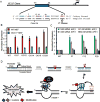8-Oxo-7,8-dihydroguanine, friend and foe: Epigenetic-like regulator versus initiator of mutagenesis
- PMID: 28629775
- PMCID: PMC5548303
- DOI: 10.1016/j.dnarep.2017.06.009
8-Oxo-7,8-dihydroguanine, friend and foe: Epigenetic-like regulator versus initiator of mutagenesis
Abstract
A high flux of reactive oxygen species during oxidative stress results in oxidative modification of cellular components including DNA. Oxidative DNA "damage" to the heterocyclic bases is considered deleterious because polymerases may incorrectly read the modifications causing mutations. A prominent member in this class is the oxidized guanine base 8-oxo-7,8-dihydroguanine (OG) that is moderately mutagenic effecting G→T transversion mutations. Recent reports have identified that formation of OG in G-rich regulatory elements in the promoters of the VEGF, TNFα, and SIRT1 genes can increase transcription via activation of the base excision repair (BER) pathway. Work in our laboratory with the G-rich sequence in the promoter of VEGF concluded that BER drives a shift in structure to a G-quadruplex conformation leading to gene activation in mammalian cells. More specifically, removal of OG from the duplex context by 8-oxoguanine glycosylase 1 (OGG1) produces an abasic site (AP) that destabilizes the duplex, shifting the equilibrium toward the G-quadruplex fold because of preferential extrusion of the AP into a loop. The AP is bound but inefficiently cleaved by apurinic/apyrimidinic endoDNase I (APE1) that likely allows recruitment of activating transcription factors for gene induction. The ability of OG to induce transcription ascribes a regulatory or epigenetic-like role for this oxidatively modified base. We compare OG to the 5-methylcytosine (5mC) epigenetic pathway including its oxidized derivatives, some of which poise genes for transcription while also being substrates for BER. The mutagenic potential of OG to induce only ∼one-third the number of mutations (G→T) compared to deamination of 5mC producing C→T mutations is described. These comparisons blur the line between friendly epigenetic base modifications and those that are foes, i.e. DNA "damage," causing genetic mutations.
Keywords: 8-Oxo-7,8-dihydroguanine; Base excision repair; Epigenetics; G-quadruplex; Mutagenesis; Oxidative stress.
Copyright © 2017 Elsevier B.V. All rights reserved.
Conflict of interest statement
Figures




References
-
- Gedik CM, Collins A. Establishing the background level of base oxidation in human lymphocyte DNA: results of an interlaboratory validation study. FASEB J. 2005;19:82–84. - PubMed
-
- Shibutani S, Takeshita M, Grollman AP. Insertion of specific bases during DNA synthesis past the oxidation-damaged base 8-oxodG. Nature. 1991;349:431–434. - PubMed
Publication types
MeSH terms
Substances
Grants and funding
LinkOut - more resources
Full Text Sources
Other Literature Sources
Research Materials
Miscellaneous

